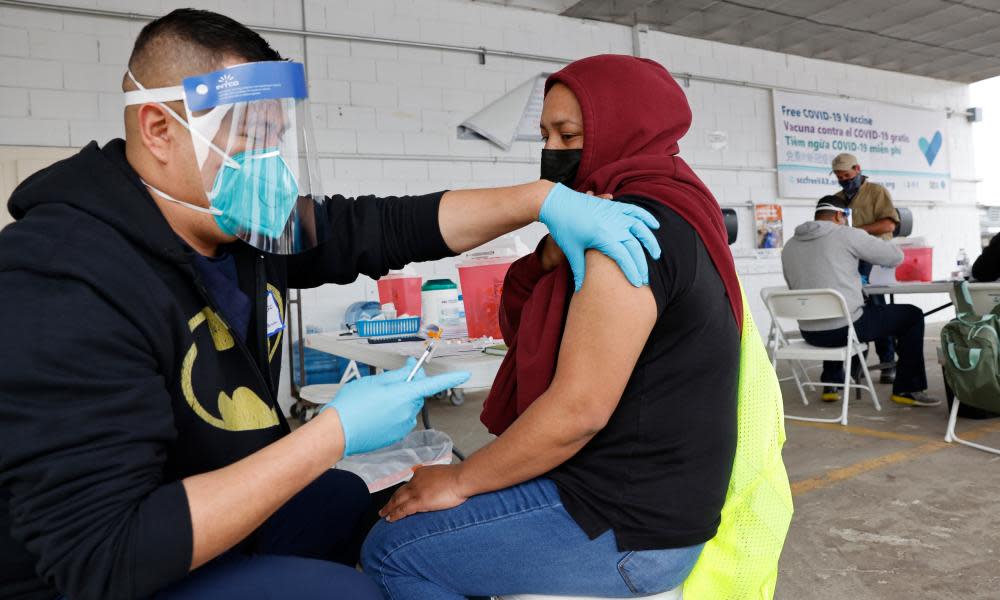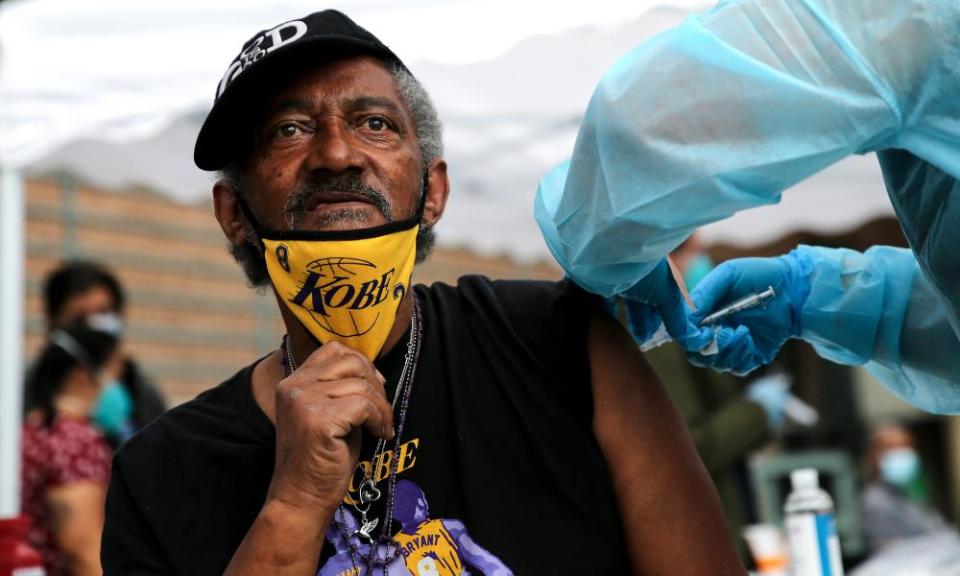California's vaccine delivery is among most unequal in the US, report finds

California has failed to equitably distribute vaccines to residents in its poorest and most vulnerable regions, according to a new report from federal researchers that found the nation’s most populous state has one of most unequal vaccine programs.
The report from the US Centers for Disease Control and Prevention (CDC) found that California ranked among the worst five states for unequal vaccine distribution. Researchers from the CDC analyzed vaccines administered from 14 December to 1 March, and compared where doses were distributed against county-level demographic data.
In the first two and a half months of its vaccine program, California has doled out a smaller proportion of its vaccines to counties with the most vulnerable residents than it has to counties with the least vulnerable. The CDC data lines up with the state’s own statistics, which found lower levels of vaccination in vulnerable neighborhoods, where a larger proportion of people are low-income, have less access to healthcare and have higher rates of Covid-19 risk factors such as asthma and heart disease.
Related: California governor gears up for recall fight as critics say they’ve reached 2m signatures
An analysis by the Kaiser Family Foundation also found stark racial disparities in the state: only 21% of vaccine doses have gone to Hispanic residents, though they account for 40% of the population and 55% of those who have tested positive for Covid-19 so far. Only 3% of the state’s vaccine doses have gone to Black residents, even though they make up 6.5% of the population.
In February, advocacy groups, doctors and public health researchers wrote a letter to the state’s governor, Gavin Newsom, asking him to “immediately correct the unequal rollout that is leaving too many frontline communities behind”.
Facing mounting criticism, Newsom announced at the beginning of March that California would dedicate 40% of its vaccine doses to the neighborhoods and zip codes hardest hit by the pandemic, including some of the poorest neighborhoods in the Central Valley and Los Angeles.

“Our hope is the data will start to look better in the next few weeks,” said Kiran Savage-Sangwan, the executive director of California Pan-Ethnic Health Network, a health equity advocacy group. In the meantime, policymakers and local providers need to “double down on removing barriers to vaccine access”, she said.
In recent weeks, Newsom’s administration has also loosened the verification process for gaining access to vaccines, so that uninsured and undocumented residents can more easily get vaccinated without needing to procure documentation from doctors or employers to prove that they are disabled or essential workers, and therefore qualify for a shot.
But at some vaccine distribution centers, residents have nevertheless reported being asked for documentation. Others have faced language barriers, or have been unable to make it to appointments during their work days. “It’s clear that we have work to do,” said Savage-Sangwan.
The CDC report has its limitations. It looked at county-level, rather than neighborhood-level data – which, in a state like California, with vast counties that contain both highly vulnerable and highly privileged neighborhoods within them, could skew results. “While this is just a first look at how the vaccine is being administered nationwide, it tells us we need to continue to ramp up our efforts to ensure fair and equitable access to Covid-19 vaccine,” said Michelle Hughes, CDC epidemiologist Michelle Hughes, to the San Francisco Chronicle.
The report found that Montana, Alaska and Arizona had done the best job of distributing vaccines to vulnerable counties. States that prioritized minority groups and allocated more vaccines to economically vulnerable areas had smaller disparities, the researchers found. But ultimately, they said, “vaccination coverage was lower in high vulnerability counties nationwide, demonstrating that additional efforts are needed to achieve equity”.
Darrel Ng, a spokesperson for California’s Covid-19 vaccine taskforce said that the report “reinforces California’s own data showing that those most impacted by the pandemic aren’t receiving vaccines at a rate commensurate with the rest of the population”.
“Vaccines are the light at the end of the tunnel, but we need to make sure that light is equally bright for all,” Ng said.
The vaccine distribution, like every other stage of the pandemic, has deepened disparities in “communities that were already suffering from enormous inequities and decades-long underinvestment”, said Wilma Franco, the executive director of the Southeast Los Angeles Collaborative, a group of non-profit organizations focused on education, health and environmental justice. Going forward, officials will have to contend with the systemic inequalities, and invest in communities like south-east LA, she said, where more people died of Covid-19 per capita than anywhere else in the county.
Earlier this week, the CDC announced a $2.25bn initiative to address the health disparities that were exposed by the coronavirus pandemic.

